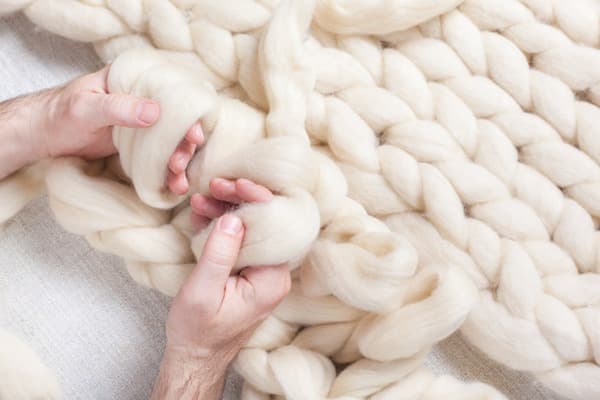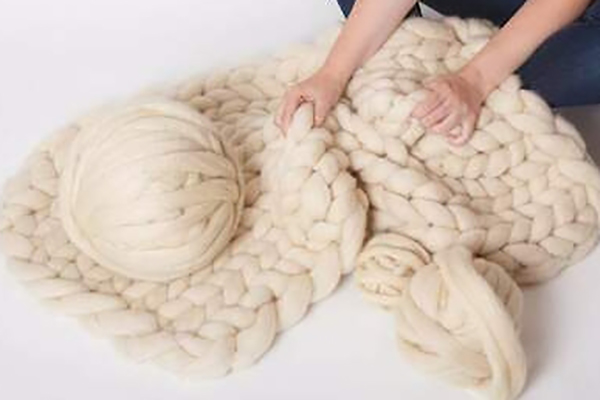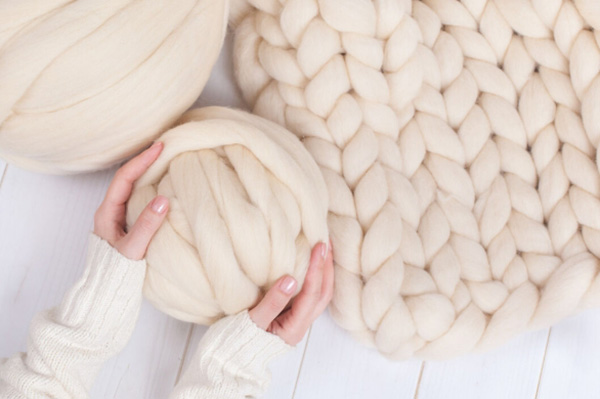Welcome to the soft, lofty, and wonderfully versatile world of roving! If you’re a knitter, weaver, spinner, or any kind of fiber craft enthusiast, you’ve likely come across this beautiful, unspun cloud of fiber. But what exactly is it, and how can you use it to create stunning projects? This guide is your definitive resource. We will explore everything from the fundamental definition of rove to advanced tips for working with this delicate material. As a manufacturer and supplier with years of experience, I, Allen, will share insights that help you master working with roving yarn, avoid common pitfalls, and unlock its full creative potential. This article is worth reading because it demystifies roving and empowers you with the knowledge to confidently incorporate it into your craft.
What Exactly Is Roving? The Foundation of Yarn
At its core, rove is a long and narrow bundle of fiber that has been processed but not yet spun into yarn. Imagine a sheep’s fleece after it has been washed and cleaned. The next step is to align the individual fibers into a continuous, untwisted strand. This strand is the rove. It’s the intermediate stage between raw, jumbled fiber and the strong, twisted yarn you typically buy on a skein. This roving yarn, as some call it, is incredibly soft and fluffy because the fibers are lying mostly parallel to each other without the tight twist that holds traditional yarn together.
This lack of twist is what gives rove its unique character. It’s lofty, airy, and has a beautiful, rustic look. However, it’s also what makes it delicate. Since it’s essentially unspun, a rove can pull apart easily if you’re not careful. Think of it as the raw ingredient for yarn. A spinner takes this rove and introduces a twist to create a durable strand. But for many modern crafters, the rove itself has become a popular choice for creating chunky, super-soft blankets, wall hangings, and other decorative items. This type of yarn preparation is all about celebrating the pure, unadulterated beauty of the fiber.
The term rove can sometimes be used interchangeably with "top," but there is a technical difference. Top is typically made from longer fibers that have been combed to ensure they are all perfectly parallel, resulting in a smoother, more lustrous preparation. Rove, on the other hand, is generally carded, a process that is slightly less intensive and can leave the fibers in a more jumbled, airy arrangement. For most knitters and crafters, this distinction is minor, but it explains why some rove products feel fluffier while others feel sleeker. The key takeaway is that rove is the essential building block that a spinner would use to spin yarn.
How Is a Rove Created from Raw Fiber?
The journey from a fluffy fleece to a usable rove is a fascinating one that involves cleaning and alignment. As a manufacturer, we handle this process on a large scale, but the principles are the same whether it’s done in a large mill or by a small-scale fiber artist. It all starts with the raw fiber, which could be wool from a sheep, soft cotton bolls, or even synthetic materials like acrylic. The first step is always scouring—a thorough washing process to remove dirt, grease (lanolin in the case of wool), and any vegetable matter.

Once the fiber is clean and dry, it needs to be opened up and aligned. This is where carding comes in. A carding machine uses large rollers covered in tiny wire teeth (carding cloth) to brush the fibers, teasing them apart and encouraging them to lie in the same general direction. This process creates a wide, flat, and airy sheet of fiber called a batt. This batt is then separated into a long and narrow bundle to create the rove. This mechanical process ensures a consistent thickness and texture in the final rove.
For finer, luxury yarns, a different process called combing is used. A comb separates out the shorter fibers, ensuring that only the longest and strongest fibers remain. These are then aligned perfectly parallel to create a very smooth and dense preparation called top. However, for the fluffy, lofty rove that is popular in chunky knitting and felting, carding is the more common method. The resulting rove is a continuous, untwisted strand ready for the next stage of its life: to be spun into yarn, used in felting, or knit directly into a cozy fabric. This preparation of the rove is crucial for the final product’s quality.
Roving vs. Traditional Spun Yarn: What’s the Real Difference for a Knitter?
For a knitter, the difference between working with rove and traditional spun yarn is like the difference between painting with watercolors versus oil paints. Both create beautiful results, but they handle very differently. The primary distinction lies in one critical element: twist. Traditional yarn is a rove that has been put through a spinning process to add strength and durability.
The twisting process locks the individual fibers together, preventing them from pulling apart. This is why you can apply significant tension to a skein of standard yarn without it breaking. Rove, or roving yarn, has little to no twist. Its fibers are held together only by the natural crimp and microscopic scales on their surface. This makes the rove incredibly soft and lofty but also fragile. When you knit with rove, you have to be much more gentle to avoid splitting the strand or pulling it apart completely.
Here is a simple table to highlight the key differences for any craft project:
| Feature | Roving | Spun Yarn |
|---|---|---|
| Structure | Unspun or loosely spun fibers | Tightly twisted fibers |
| Strength | Low; can pull apart easily | High; durable and resilient |
| Texture | Extremely soft, airy, fluffy | Varies, but generally denser |
| Definition | Creates soft, blended stitches | Creates crisp, well-defined stitches |
| Best For | Decorative items, felting, spinning | Garments, socks, high-wear items |
| Handling | Requires special care and gentle handling | Easy to handle, withstands tension |
Understanding these differences is crucial for choosing the right material. If you’re making a sock or a sweater that will see a lot of wear, a durable, spun yarn is the best choice. For a decorative wall hanging, a chunky arm-knit blanket, or a felting project, the unparalleled softness and rustic look of a rove are ideal. The rove is a specialty material that shines in specific applications.
What Are the Most Common Types of Roving Fiber?
The world of fiber is vast, and rove can be made from a wide variety of materials, each with its own unique properties. The type of roving you choose will significantly impact the look, feel, and function of your finished project. As a supplier, we work with many different fibers to meet the needs of various textile arts.
The most popular and traditional fiber for rove is undoubtedly wool. Wool roving is beloved by spinners and felters alike. The scales on the surface of wool fibers help them cling together, making them easy to spin and ideal for both wet felting and needle felting. Merino wool, in particular, produces an incredibly soft and fine rove that is gentle enough to be worn against the skin. Other sheep breeds offer rove with different characteristics—some are more durable, others have more crimp and bounce.
Beyond wool, many other fibers are available in rove form:
- Alpaca: Luxuriously soft and warm with a beautiful drape. It lacks the "memory" of wool but is prized for its silky texture.
- Cotton: A plant-based fiber that is absorbent and breathable. Cotton rove can be a bit more challenging to spin because its fibers are shorter and smoother than wool.
- Silk: Known for its incredible luster, strength, and smoothness. Silk rove is often blended with other fibers like merino to add a touch of luxury.
- Synthetic Fibers: Materials like acrylic and nylon are also made into rove. They are often less expensive, come in vibrant colors, and are easy to care for. An acrylic rove is a great option for beginners or for projects where washability is a key concern.
- Blends: Many of the most interesting rove products are blends of different fibers, combining the best qualities of each. A merino/silk blend, for example, offers both softness and shine.
Choosing the right fiber is the first step in any successful rove project. Consider what you’re making and what properties are most important to you—softness, durability, warmth, or ease of care.
Can You Knit or Crochet Directly with Roving?
Yes, you absolutely can knit or crochet directly with rove! This technique has become incredibly popular for creating super bulky and chunky items, especially in arm knitting and giant knitting with oversized needles. Using roving yarn this way produces a fabric with a unique, lofty texture and incredible softness. It’s a fun and fast way to create dramatic pieces, and it’s especially fun to work with.

However, working with roving directly requires a different approach than with standard yarn. Because the rove is unspun, it has very little tensile strength. You must handle it carefully to prevent it from drifting apart. When you pull the rove to make a new stitch, do so gently. The key is to support the rove and avoid putting too much strain on any single section. Some crafters find it helpful to introduce a slight twist into the rove with their fingers as they work, which adds a bit of temporary strength.
It’s also important to note that fabric made from unspun rove will be very delicate. It is prone to pilling and shedding, so it’s not suitable for items that will get a lot of friction or wear. This is why rove is best to use for decorative items like blankets (meant for gentle use), wall hangings, or a dramatic cowl accessory. For a project requiring more durability, consider a lightly spun singles yarn, which maintains a roving-like look but has added strength from a minimal twist.
What Are the Best Projects for Using Roving?
The unique properties of rove make it the perfect material for specific types of projects where softness and visual impact are more important than durability. Its bulky nature means projects work up incredibly quickly, offering instant gratification for any craftsy enthusiast.
Here are some of the most popular and best-suited projects for using roving:
- Chunky Arm-Knit Blankets: This is perhaps the most famous use for thick wool rove. By using your arms as a giant circular needle, you can create a plush, oversized blanket in just a few hours. The result is a statement piece that is both visually stunning and incredibly cozy.
- Weaving and Wall Hangings: Rove is a weaver’s dream for adding bold texture and softness to tapestries. You can weave with thick sections of rove to create fluffy clouds and dramatic lines in your design. Its lack of twist allows it to fill space beautifully.
- Felting: Rove is the primary material for both wet felting and needle felting. In wet felting, layers of wool rove are agitated with hot, soapy water to cause the fibers to mat together into a solid piece of fabric. For needle felting, a special barbed needle is used to poke the rove, tangling the fibers to create three-dimensional sculptures and embellishments.
- Thrumming: This is a technique where small pieces of rove are knit into a fabric to create a fleecy, super-warm lining. It is commonly used for making extra-cozy mittens and socks. The unspun rove on the inside eventually felts with use, creating a windproof layer.
- Spinning: Of course, the most traditional use for rove is as the raw material for spinning. A spinner can take a rove and draft it out to their desired thickness before adding twist to create their very own custom yarn.
For more durable needs where the aesthetic of a thick yarn is desired, consider options like our high-quality Yarn ball, which offers consistency and strength for a wide range of craft projects.
Essential Tips for Successfully Working with Roving Yarn
Working with roving can be a joy, but its delicate nature can be frustrating for the uninitiated. As someone who sees these materials produced from start to finish, I can offer some practical advice to make your experience smooth and successful. The best way to handle rove is with a gentle touch and a bit of patience.
Here are some essential tips for knitting, crocheting, or weaving with rove:
- Manage Your Tension Loosely: Unlike with spun yarn, where tight, even tension is often the goal, you need to keep your stitches loose when using rove. Pulling too tightly will stretch the thin spots in the rove and cause it to break. Let the rove glide through your fingers rather than gripping it.
- Pre-Draft the Roving: Before you start knitting, it can be helpful to gently pre-draft your rove. This means pulling it slightly to even out any thick and thin spots. Do this carefully along a long section to distribute the fibers more evenly, making the strand more consistent and slightly stronger.
- Support the Strand: Never let the weight of your project hang from the working strand of rove. Keep your ball or bundle of rove close to you so there is minimal strain on the fiber between the ball and your hands or needles.
- Join New Sections Carefully: When you need to add a new length of rove, don’t tie a knot. Instead, use a felting technique. Taper the ends of both the old and new strands, overlap them by a few inches, and rub them together vigorously between your palms with a tiny bit of moisture. The friction will cause the fibers to mesh together, creating a nearly seamless join.
- Choose the Right Tools: Use large needles or a hook with a smooth, rounded tip. Sharp points can easily split the delicate narrow bundle of fiber. Bamboo or wood needles are often a good choice as they have a bit more grip than metal, which can help you control the lofty rove.

How Do You Spin Rove into Your Own Custom Yarn?
For many fiber artists, the ultimate expression of creativity is to spin their own yarn. A rove is the perfect starting point for this journey. Spinning is the process of drafting (pulling out) fibers from a rove while simultaneously adding twist with a spindle or spinning wheel. This twist is what transforms the fragile rove into a strong, elastic, and durable yarn.
The basic process of spinning a rove involves three main actions:
- Drafting: This is the act of pulling a small number of fibers from the main supply of rove. The amount of fiber you draft at one time determines the thickness of your final yarn. For a thin yarn, you draft fewer fibers; for a thick yarn, you draft more.
- Adding Twist: As you draft, you use a tool to rotate the fibers, introducing the twist. A drop spindle is a simple, portable tool, while a spinning wheel (powered by a treadle) allows for faster and more consistent production. The twist runs up into the drafted fibers, locking them together.
- Winding On: Once a length of yarn has been spun, you wind it onto the spindle or the wheel’s bobbin to keep it from untwisting and to make way for the next section.
Learning to spin takes practice, but it’s a deeply rewarding skill. It allows you to control every aspect of your yarn—its thickness, the amount of twist, the color combinations, and the final style. You can take a beautifully dyed rove and spin a one-of-a-kind yarn that is perfectly suited to your next project. This is the heart of textile arts—transforming raw material into something both beautiful and functional.
What Common Mistakes Should You Avoid with Rove?
As with any specialized material, there’s a learning curve to using rove. Being aware of the common pitfalls can save you a lot of time and frustration. From my experience in production and seeing how customers use our products, a few mistakes come up frequently.
First, a common issue is uneven tension, which leads to a lumpy, inconsistent fabric. When knitting with rove, if you pull one stitch tighter than the next, it will be very noticeable. The tight stitch will compress the fluffy fibers, while the loose one will bloom. The key is to practice a light, consistent touch. Don’t be afraid to pull back a few rows if you notice the tension going awry. A related problem is breakage. A beginner knitter might treat the rove like a sturdy worsted-weight yarn and put too much force on it, causing it to snap. Remember, it’s a narrow and unspun bundle; treat it gently.
Another mistake is choosing the wrong project for the material. Making a high-friction item like a tote bag or a fitted sweater out of pure, unspun rove is setting yourself up for disappointment. The item will pill and shed almost immediately. The rove is a popular choice for items that won’t be handled roughly. If you love the look of rove but need durability, consider a "pencil roving" or a lightly spun yarn, which offers a similar aesthetic with more strength. Or, for projects demanding ultimate durability without the fluffy texture, a material like Bundle polyproplene yarn might be a more suitable, albeit different, choice. Lastly, improper joining can ruin the look of a project. A bulky knot in a rove piece is unsightly. Take the time to learn the felted join method for a professional finish.
How Do You Care for Your Finished Roving Projects?
Once you’ve created a lovely piece with rove, you’ll want to keep it looking beautiful for as long as possible. Proper care is essential because, as we’ve discussed, fabric made from unspun rove is delicate. It requires more gentle handling than items made from conventional yarn.
The most important rule for caring for a rove item, especially if it’s made of wool, is to avoid agitation and heat, as this will cause it to felt. You should never put a chunky rove blanket in the washing machine. The combination of water, soap, and movement will turn your soft, lofty creation into a stiff, matted fabric. Spot cleaning is the best way to deal with small spills. Use a damp cloth and a very mild detergent, and gently dab the affected area. Do not rub, as this will cause pilling.
For a more thorough cleaning, you can hand wash the item very carefully. Fill a tub with cool water and a no-rinse wool wash. Submerge the item, let it soak without agitation, and then gently squeeze out the excess water. Never wring or twist it. To dry, roll the item in towels to absorb most of the moisture, then lay it flat on a dry surface, away from direct sunlight or heat. Due to the thick nature of these projects, they can take a very long time to dry. Regularly de-pilling your item with your fingers or a fabric shaver will also help keep it looking fresh. This special care will ensure your rove project remains a cherished piece. For projects where easy care is a priority, using a machine-washable material like our durable Cotton Yarn is a practical alternative.
Key Takeaways to Remember
- Rove is Unspun Fiber: It’s the soft, untwisted bundle of fiber that is the precursor to yarn. Its main characteristics are loftiness and fragility.
- Handle with Care: Always use a gentle touch when knitting, weaving, or handling rove to prevent it from stretching thin or pulling apart.
- Choose the Right Project: Rove is best for decorative items like chunky blankets, wall hangings, and felting projects, not for high-wear garments.
- Master the Felted Join: Avoid knots when adding a new section of rove. Overlap the ends and rub them together to create a seamless, felted join.
- Clean Gently: Never machine wash a project made from rove. Spot clean or hand wash very carefully in cool water and always lay flat to dry.





